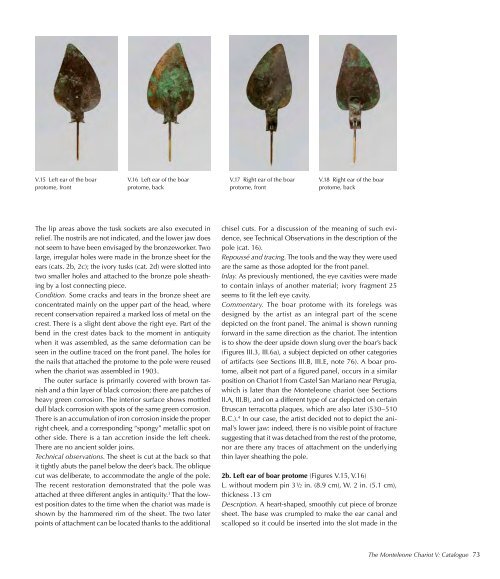Journal - Comune di Monteleone di Spoleto
Journal - Comune di Monteleone di Spoleto
Journal - Comune di Monteleone di Spoleto
Create successful ePaper yourself
Turn your PDF publications into a flip-book with our unique Google optimized e-Paper software.
V.15 left ear of the boar<br />
protome, front<br />
V.16 left ear of the boar<br />
protome, back<br />
The lip areas above the tusk sockets are also executed in<br />
relief. The nostrils are not in<strong>di</strong>cated, and the lower jaw does<br />
not seem to have been envisaged by the bronzeworker. Two<br />
large, irregular holes were made in the bronze sheet for the<br />
ears (cats. 2b, 2c); the ivory tusks (cat. 2d) were slotted into<br />
two smaller holes and attached to the bronze pole sheathing<br />
by a lost connecting piece.<br />
Con<strong>di</strong>tion. Some cracks and tears in the bronze sheet are<br />
concentrated mainly on the upper part of the head, where<br />
recent conservation repaired a marked loss of metal on the<br />
crest. There is a slight dent above the right eye. Part of the<br />
bend in the crest dates back to the moment in antiquity<br />
when it was assembled, as the same deformation can be<br />
seen in the outline traced on the front panel. The holes for<br />
the nails that attached the protome to the pole were reused<br />
when the chariot was assembled in 1903.<br />
The outer surface is primarily covered with brown tarnish<br />
and a thin layer of black corrosion; there are patches of<br />
heavy green corrosion. The interior surface shows mottled<br />
dull black corrosion with spots of the same green corrosion.<br />
There is an accumulation of iron corrosion inside the proper<br />
right cheek, and a correspon<strong>di</strong>ng “spongy” metallic spot on<br />
other side. There is a tan accretion inside the left cheek.<br />
There are no ancient solder joins.<br />
Technical observations. The sheet is cut at the back so that<br />
it tightly abuts the panel below the deer’s back. The oblique<br />
cut was deliberate, to accommodate the angle of the pole.<br />
The recent restoration demonstrated that the pole was<br />
attached at three <strong>di</strong>fferent angles in antiquity. 3 That the lowest<br />
position dates to the time when the chariot was made is<br />
shown by the hammered rim of the sheet. The two later<br />
points of attachment can be located thanks to the ad<strong>di</strong>tional<br />
V.17 right ear of the boar<br />
protome, front<br />
V.18 right ear of the boar<br />
protome, back<br />
chisel cuts. For a <strong>di</strong>scussion of the meaning of such evidence,<br />
see Technical observations in the description of the<br />
pole (cat. 16).<br />
Repoussé and tracing. The tools and the way they were used<br />
are the same as those adopted for the front panel.<br />
Inlay. as previously mentioned, the eye cavities were made<br />
to contain inlays of another material; ivory fragment 25<br />
seems to fit the left eye cavity.<br />
Commentary. The boar protome with its forelegs was<br />
designed by the artist as an integral part of the scene<br />
depicted on the front panel. The animal is shown running<br />
forward in the same <strong>di</strong>rection as the chariot. The intention<br />
is to show the deer upside down slung over the boar’s back<br />
(Figures iii.3, iii.6a), a subject depicted on other categories<br />
of artifacts (see Sections iii.B, iii.e, note 76). a boar protome,<br />
albeit not part of a figured panel, occurs in a similar<br />
position on Chariot i from Castel San mariano near Perugia,<br />
which is later than the monteleone chariot (see Sections<br />
ii.a, iii.B), and on a <strong>di</strong>fferent type of car depicted on certain<br />
etruscan terracotta plaques, which are also later (530 – 510<br />
B.C.). 4 in our case, the artist decided not to depict the animal’s<br />
lower jaw: indeed, there is no visible point of fracture<br />
suggesting that it was detached from the rest of the protome,<br />
nor are there any traces of attachment on the underlying<br />
thin layer sheathing the pole.<br />
2b. Left ear of boar protome (Figures V.15, V.16)<br />
l. without modern pin 3 1⁄2 in. (8.9 cm), W. 2 in. (5.1 cm),<br />
thickness .13 cm<br />
Description. a heart-shaped, smoothly cut piece of bronze<br />
sheet. The base was crumpled to make the ear canal and<br />
scalloped so it could be inserted into the slot made in the<br />
The <strong>Monteleone</strong> Chariot V: Catalogue 73


